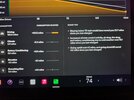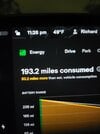Here is my experience with an LFP battery Model 3:
- ~9.5 months since delivery.
- ~11,500 miles since delivery.
- Mostly economical driving, averaging similar to or better than the EPA rating.
- Scheduled departure charging -- usually drive off 0-2 hours after charging finishes.
- Usually charging to 65-70%.
- Charging to 100% approximately once per week, usually when expected use is >30%.
- Current displayed rated range at 100% is 266 miles, down from original 272 miles (-2.2%).
- Initially fluctuated between 271 and 273 miles, then declined over the next several months, but has been at 266 for a few months.Note that
Note that the above minimize time parked at 100%, and avoid overnight parking at >70%.
Would it be different with different driving or charging habits?




